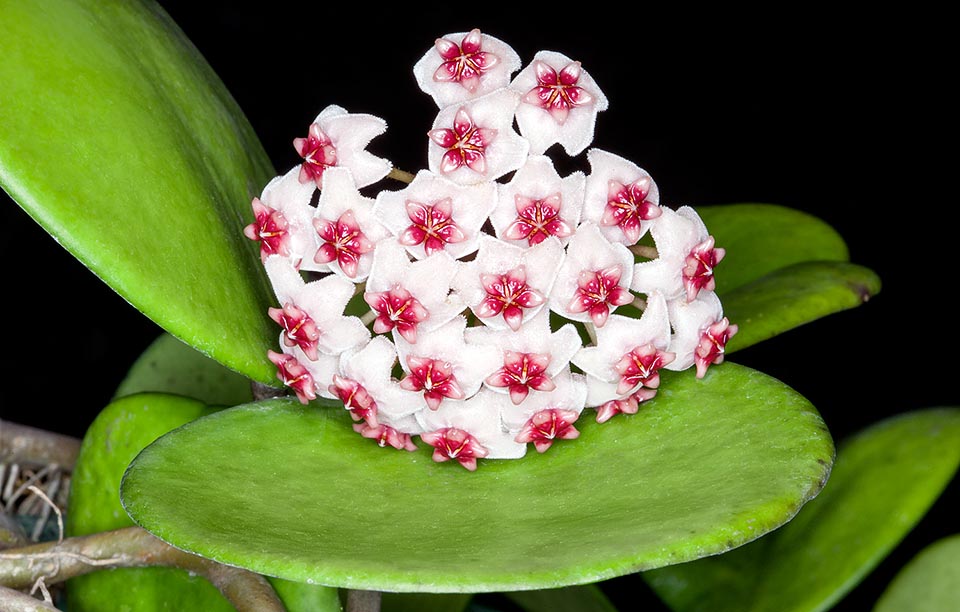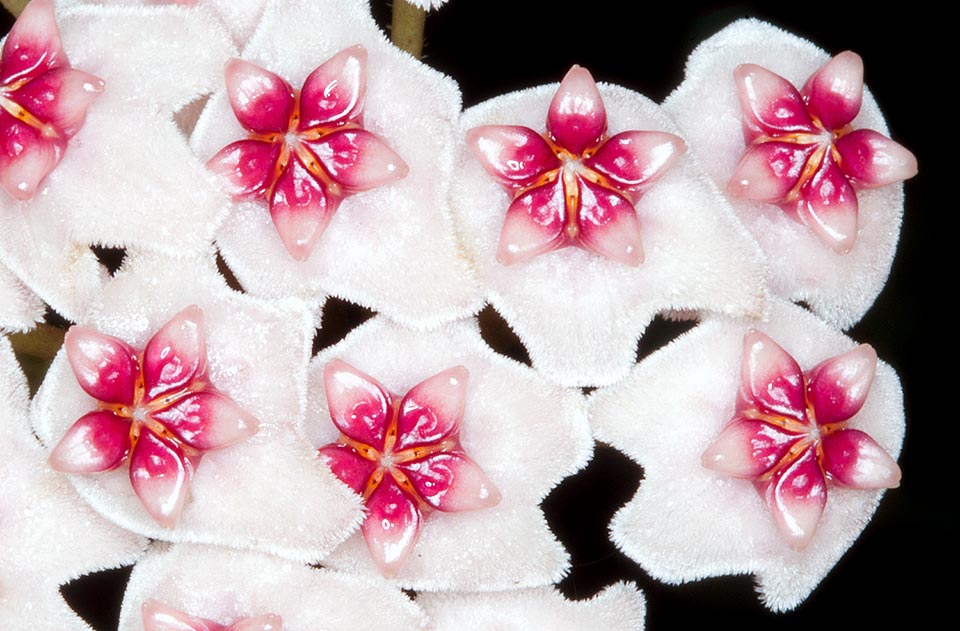Family : Apocynaceae

Text © Pietro Puccio

English translation by Mario Beltramini
The species is native to Indonesia (Moluccas and Sulawesi) where it grows as epiphyte on the trees of the humid forests.
The genus is dedicated to Thomas Hoy (ca. 1750-1822), botanist and curator of the gardens of the duke of Northumberland; the specific name is the Latin adjective “obovatus, a, um” = obovate, with reference to the shape of the leaf.
The Hoya obovata is a climbing evergreen epiphyte with stems that can reach the length of some metres, provided of adventitious roots with which it anchors on the supports. The leaves, on a 1-2 cm long petiole, are opposite, simple, obovate with rounded apex, rarely retuse, and curved entire margins, 6-12 cm long and 5-8 cm broad, thick, glossy, of intense green colour with scattered silvery grey spots. Umbel axillar inflorescences bearing up to more than 25 flowers, of about 1,5 cm of diameter, with a 5 ovate lobes corolla with obtuse apex, retroflexed, of slightly pinkish white colour, glabrous outside, papillose inside, and crown with almost rhomboidal lobes, umbilicate at the centre, of intense pink colour; the flowers, long lasting, about 2 weeks, emit a pleasant fragrance, in particular after the nightfall, and produce abundant transparent nectar.

The Hoya obovata is a strong epiphyte of Indonesia with stems climbing for various metres thanks to solid adventitious roots © Giuseppe Mazza
It usually propagates by cutting, with 2-3 nodes, in very sandy loam or agriperlite maintained humid at a temperature of 26-28 °C, and by air layering. Less frequently, it reproduces by seed, in late spring , placed superficially on organic loam with addition of siliceous sand per a 30% maintained constantly humid, but without stagnations.
Species discussed on the point of view of the nomenclature, being no agreement among the scholars whether to consider it as a species or a synonym, often mistaken with the Hoya kerrii Craib. Vigourous, of easy cultivation and fast growth, it is cultivable in open air in the tropical, subtropical and marginally temperate-warm climate zones, where it can resist, dry, to temperatures of some degrees over the 0 °C, if exceptional and short lasting.

The perfumed corollas, of about 1,5 cm of diameter, last two weeks, united in umbel inflorescences that count even more than 25 elements © Giuseppe Mazza
It requires a particularly aerated and draining substratum, being the roots easily subject to rottenness due to stagnating humidity, rich of organic substance, neutral or slightly acidic, and regular and abundant waterings in summer, but allowing substratum to dry up before giving water again, speced in winter, so to maintain a slight constant humidity; useful are in summer the nebulizations with non calcareous water at ambient temperature in presence of dry air and of high temperatures. For the fertilizations may be used the same products suggested for the epiphytic orchids. The repottings are to be done when the substratum show signs of deterioration, preferably between spring and early summer, taking care to leave then the plant dry for several days, till when are noted signs of vegetative regrowth.
→ To appreciate the biodiversity within the APOCYNACEAE family please click here.
